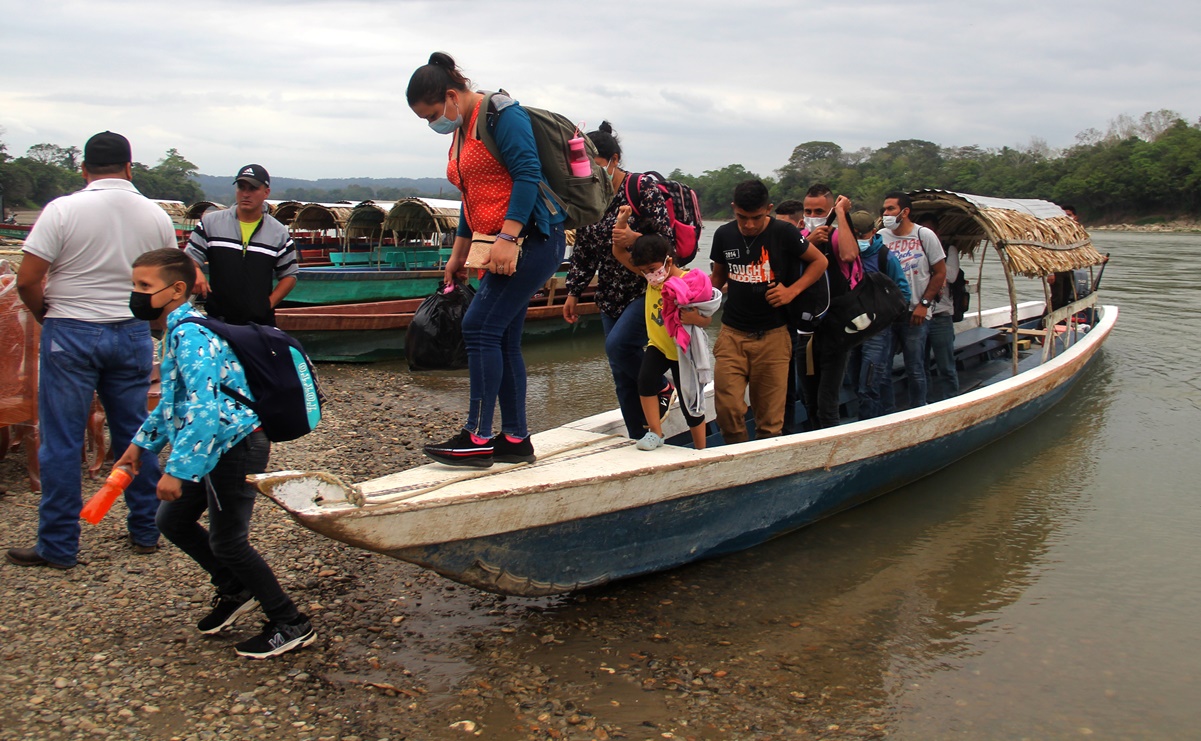
Corozal border. – In the middle of the howls of monkeys and the song of birds, tens of Migrants from Central America crosses daily irregularly at Mexican territory aboard boats through Usumacinta River, which serves as a political division between Mexico and Guatemala, a place where, until the weekend, it was not sanitary filter no security.
While the federal government strengthens the presence of the elements of National Institute of Migration (INM) and National Guard (GN) In Tapachula and the banks of the Suchiate River, migrants enter the national territory without anyone stopping them, more than 560 kilometers to the northeast, between the Lacandon jungle.
On this border, located 165 kilometers from the Palenque municipal residence and almost two kilometers from the Yaxchilán archeological site, navigating the Usumacinta River – the largest river in Mexico and the longest in Central America– Arrival of boats loaded with young men and women carrying their minor children, mainly from Honduras, Guatemala, and Savior.
Read also: Border agents release migrants without detention in the United States: NBC News
This route is used by smugglers and migrants traveling alone, thanks to zero surveillance by the INM, the National Guard and the Mexican army.
During a tour last Saturday, it was observed that dozens of migrants arrive from Guatemala in the city known as La Técnica, where they board boats crossing the river to the Corozal Border, belonging to the municipality of Ocosingo.

On the Mexican side, traffickers have already hired local taxi drivers to transport people to safe homes. Foreigners traveling alone are deprived of the little money that alleged Guatemalan police carry as payment for not being detained and repatriated to their countries of origin.
They have to walk, for up to seven days, along the side of the road and in sections through the jungle, to Palenque, their first destination.
At this border point, between the Montes Azules Biosphere Reserve and the Sierra del Lacandón National Park, until last weekend the government did not send personnel to prevent the passage of undocumented migrants, as was done in Tapachula under restrictions that began on March 19. , valid for 30 days, to contain the entry of migrants. The presence of medical staff has not been strengthened to implement the health protocols imposed by pandemic of Covid-19.
Read also: They are arresting 95 Central American migrants who tried to cross Mexico as tourists
In this area, the risk is not stopped by migration, but by snakes and jaguars.

Among foreigners there are women who travel with children and minors.
With free passage
The border points with Guatemala from El Ceibo, to Tenosique, Tabasco, as well Corrosive border and Benemérito de las Américas, in Chiapas, are the routes used by smugglers and migrants. Until last Saturday, they were without the supervision of any federal corporation; only the control points of the local authorities are respected.
Among the howls of monkeys swaying in giant trees and the singing of various birds, such as quetzals, parrots, cucha and parrots of various kinds, small caravans of migrants who have no money to pay for transportation, go next Jungle Lacandon, Jaguar Territory.
Along the highway between Frontera Corozal and Palenque, groups of foreigners are observed walking day and night.
Antonio, Daniel and Jairo are part of a group of 12 young Hondurans who have been walking for three days. I ask for some water and food to move forward. They estimate they will arrive in Palenque in another four days.
Read also: 53 migrants from Central America rescued in Veracruz
They look tired. They say they try to walk a little at night, but are afraid of being attacked by snakes or a jaguar because there are precautionary notices to be a feline area.
The Chol and Lacandon natives living in the region point out that they observe the passage of migrants daily, many of them demanding shoes, food and water.
After traveling 165 kilometers, men and women take a break at the municipal headquarters in Palenque. Some stay at the Jtatic Samuel Ruiz guesthouse. Last Friday, half a thousand migrants were spotted resting near the site.

De Tabasco
Income for Tenosique, Tabasco, is no less harsh. In this regard, it was observed that foreigners enter the national territory through blind spots on the border of El Naranjo, Guatemala-El Ceibo, Mexico, walking a distance of 64 kilometers along the railway and swampy pastures, at higher temperatures. high 36 degrees.
After a walk of four to five days, the migrants stop in hostel La 72, located in Tenosique, and then continues its journey to Palenque, where it will continue its journey to the border with the United States, along the route that crosses the states of Veracruz and Tamaulipas. The hardest part is yet to come.